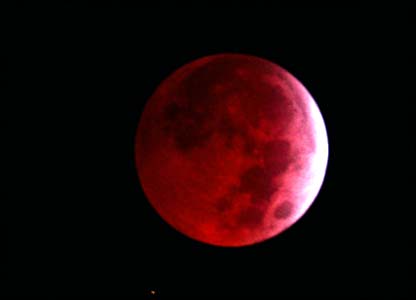There are, however, a few holidays which have not passed quite yet. The Winter Solstice (also known as Yule), Christmas, and the Gregorian New Year (the one on January 1st) are still to come. Actually, now that I look at the calendar, I see the Islamic New Year, as well, plus what I call the "other" Eid. So, I haven't completely blown over those of you who celebrate Islamic holidays.
That's five holidays, plus the rest of Hanukkah. Five and one-third holidays.
Therefore, I hereby declare, "Happy holidays!"
Something else caught my eye, though. This is not a holiday, but it's still in December, it's still on the calendar, and hey, it even falls on the Winter Solstice.
 |
| The Moon, in a partial eclipse. |
It's a lunar eclipse. Before you roll your eyes, however, I would like to say a few things about this particular eclipse.
First, it's total. That's not to say everyone in the world will be able to see the eclipse. For a lot of people, the eclipse will happen either when the moon has already set or when it's about to rise/set. I found a chart on the net showing where you can see the eclipse:
 |
| This chart shows where one can see the eclipse. It isn't frilly, but it does the job. |
If you're anywhere in North America, you're in luck-- you will get a perfect view (unless some clouds come along). Most of South America will also be able to see all of it. If, however, you live in the Middle East, India, almost anywhere in Africa, parts of China, or anywhere else in the darkest area of the map, you will not be able to see it at all, I'm afraid. Japan, almost all of Europe, parts of South America, and the eastern Oceania are lighter greys. The darker the grey, the less you will be able to see if you live in that area.
Those of you in New Zealand, for instance, will see the moon rise in a partial eclipse, and if you're in northeastern Australia you'll be able to see... well, according to Ian Musgrave of Southern Sky Watch, "the Moon should appear dimmer than normal, and as it rises there should be a gradual brightening of the southern part of the Moon, more easily seen as the sky darkens." It will be that way for far eastern Indonesia, some of northern China, eastern Malaysia, and anywhere you see that is near the line labeled "U3" on the eastern side of the dark part.
My guess is that people in much of Europe, all of Uruguay, far eastern Brazil, and southeastern Argentina will have the same experience, but reversed: as the moon sets, it will get dimmer than normal, starting with the southern part of the moon. I think so, anyway.
If you would like to see the lunar eclipse on December 21, I would recommend looking at the map. If you will be able to see the eclipse in your area, you don't need a telescope to see it. (In my humble opinion, it looks better without a telescope than with one.)
Also, last but not least:
 |
| I could not resist the temptation to reference this book, which I have not read. |
No comments:
Post a Comment